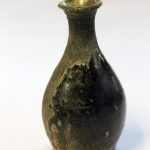Worse than any ocular affliction is the failure of the mind to see honestly. The unsighted person can come to terms with a work of pottery through tactile and even, on tapping lightly, auricular perception. Yet all too many ostensibly sighted individuals fail to see what is before their eyes.
Take a look around you at a museum. See how people tend to read the labels—artist, year, medium—before looking directly at the works in question. “Michaelangelo! Such greatness.” Alternatively, “Sebastiano? Who?” Or in a pottery exhibition of classic Raku works: “Chojiro! The greatest!” Or perhaps, depending on your taste, “Hon-ami Koetsu! Ugh.”
We blind ourselves in advance with our prejudices about who and what we think we like and who and what we’ve decided that we don’t like. Try this experiment. Next time you attend an exhibition, make a conscious effort to look directly at the works before reading the labels. See if you don’t find yourself liking something by an artist you’d decided you disliked. And vice-versa.
We in Japan are suckers, especially, for such designations as “National Treasure” and “Important Cultural Property.” To have even a passing acquaintance with the selection process that underlies such designations is to hold them in contempt. But most museum visitors, blissfully ignorant of that process, surrender their aesthetic judgment in whole to the labeling.
Let us note here that insight accrues not from wallowing in information that we already possess but, rather, from a proactive receptivity to what we don’t know. Pottery appreciation, like all aesthetic undertakings, depends on seeing clearly. And the sense organ that we require for that seeing is an open and honest mind.






